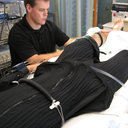Exercise and diet-induced weight loss attenuates oxidative stress related-coronary vasoconstriction in obese adolescents.
Parole chiave
Astratto
Obesity is a disease of oxidative stress (OS). Acute hyperoxia (breathing 100 % O(2)) can evoke coronary vasoconstriction by the oxidative quenching of nitric oxide (NO). To examine if weight loss would alter the hyperoxia-related coronary constriction seen in obese adolescents, we measured the coronary blood flow velocity (CBV) response to hyperoxia using transthoracic Doppler echocardiography before and after a 4-week diet and exercise regimen in 6 obese male adolescents (age 13-17 years, BMI 36.5 ± 2.3 kg/m(2)). Six controls of similar age and BMI were also studied. The intervention group lost 9 ± 1 % body weight, which was associated with a reduced resting heart rate (HR), reduced diastolic blood pressure (BP), and reduced RPP (all P < 0.05). Before weight loss, hyperoxia reduced CBV by 33 ± 3 %. After weight loss, CBV only fell by 15 ± 3 % (P < 0.05). In the control group, CBV responses to hyperoxia were unchanged during the two trials. Thus weight loss: (1) reduces HR, BP, and RPP; and (2) attenuates the OS-related coronary constrictor response seen in obese adolescents. We postulate that: (1) the high RPP before weight loss led to higher myocardial O(2) consumption, higher coronary flow and greater NO production, and in turn a large constrictor response to hyperoxia; and (2) weight loss decreased myocardial oxygen demand and NO levels. Under these circumstances, hyperoxia-induced vasoconstriction was attenuated.


